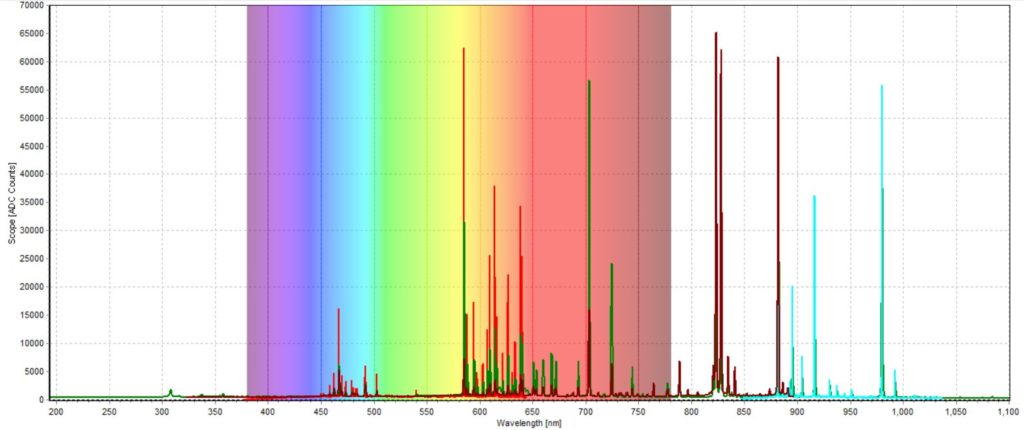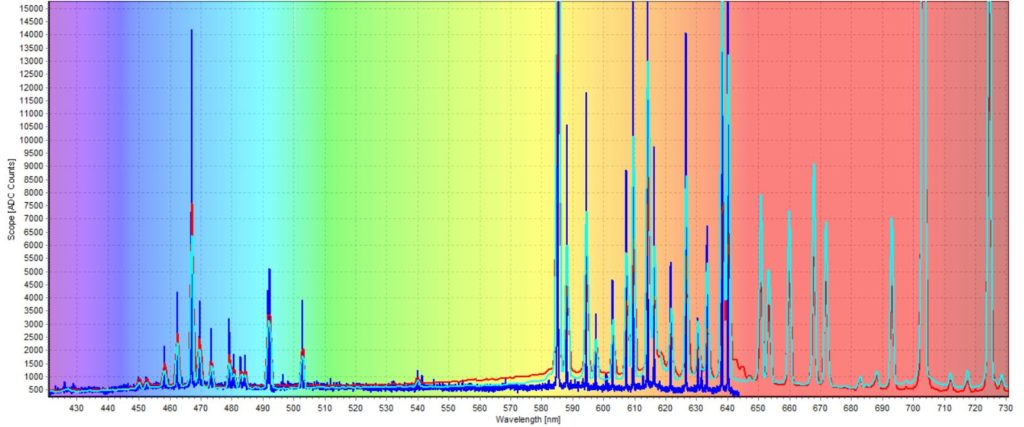Plasma Measurements and Diagnostics
Background/Applications:
Optical Emission Spectroscopy, often referred to as OES, is a widely used analytical method to determine the elemental composition of a broad range of metals. Types of samples which can be tested using OES include samples from the melt in primary and secondary metal production, and in the metals processing industry. OES commonly uses the range of 130 nm to approximately 800 nm. Therefore, high resolution may be needed to see different spectral lines depending on the metal sample.
All OES analyzers contain three major components: an electrical source to excite atoms within a metallic sample to emit characteristic optical emission lines, an optical system to collect the light and a computer system to display the spectrum.
Conducted by: David Ademe, Avantes Inc.
Description of System:

Figure 1: The setup for the plasma experiment
In this setup, we will be using a multichannel housing developed by Avantes Inc in order to house four AvaSpec-Mini spectrometers in the same housing. The housing contains four AvaSpec-Mini spectrometers synced together via an interface cable. All spectrometers then converge into a single USB hub which is then connected to the computer. The housing is approximately 7”x7”x5” and provides ample space for four (and potentially 5) AvaSpec-Mini. From the multichannel unit, a four-furcated fiber will be used in order to merge all four units into a single measurement spot. For this experiment, we will simply be measuring a single point on a store-bought plasma ball to demonstrate the spectral lines emitted in OES testing. This setup will also display the versatility of the AvaSpec-Mini.
Description of Methodology:
For this experiment, the Avantes software AvaSoft was utilized. Within AvaSoft, there are various modules for different types of spectroscopic measurements. The default module upon opening the software is Scope mode. In scope mode, you can see the raw scope/photon counts displayed across the wavelength range of your spectrometer. For some applications, such as plasma measurements and fluorescence experiments, scope mode is the best approach to capture your spectra.
One of the many advantages of AvaSoft is the ability to synchronize and merge multiple spectrometers to display a single spectrum. This allows you to have high resolution across a wider wavelength range. For example, if your application requires high resolution across the entire visible range, you could merge multiple spectrometers into displaying one unified spectrum.
Test Data and Results:
Displayed below is the scope data from the plasma ball as collected by the multichannel mini.
Analysis:
The plasma ball provides an accurate representation of the spectral lines that are visible during OES measurements. Thanks to the multichannel ability of AvaSoft, it is possible to view the plasma spectrum in four separate channels and as one merged and unified channel. This gives us the ability to analyze the spectral lines across a wide range at high resolution.
Conclusion:
In conclusion, the AvaSpec-Mini is an excellent compact unit for handheld measurements and OEM applications. It is well suited for OES and plasma measurements, and is well capable of providing reliable data. The AvaSpec-Mini can also be synchronized with multiple units to provide high resolution measurements across a wide spectrum.
Like this Article?
Sign up for our newsletter to receive a monthly digest of our latest and greatest photonics content!
 My Cart
My Cart 


